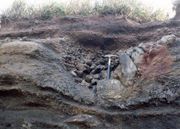Volcanic hazards
火山研究解説集:薩摩硫黄島 (産総研・地質調査総合センター作成)
| Contents: Satsuma-iojima |
|---|
- Volcanic bombs and pyroclastic flow deposits on the western foot of Iodake
As Satsuma-iojima is an active volcano, emissions of volcanic gas accompanied with micro-earthquakes are continuing. Also occasionally eruptions with ejections of altered volcanic ash are seen.
In this chapter, possible volcanic hazards in Iojima are briefly discussed.
Volcanic gas
About 1,300 tons of sulfur dioxide (SO2) is emitted from the summit crater everyday. SO2 is a cause of acid rain and eats away metals. It causes damage to human respiratory system and mucous membrane. Even at low concentrations it may trigger asthmatic symptoms at long exposure let alone at high concentrations. At worst acute attack may lead to deaths. Luckily, the main source of the gas is at high altitude at the summit crater and the settlements are on the windward side of the prevailing wind lessening the danger of people continuously being exposed to highly concentrated SO2 gas. However, proper precautions are essential when approaching the crater area, including paying attention to wind direction and wearing gas mask if necessary.
Eruptions of volcanic ashes and pumices
Volcanic bombs and pyroclastic flow deposits on the western foot of Iodake
Amount of ashfall accompanying small-scale eruptions since 1998 have been small and their influence to the daily life was limited. However, eruption deposits around Iodake in the last 1,000 years reach over 1 m inthickness suggesting that if the eruption becomes more active than the present, the amount of ejecta would become large. Increased ash ejection would cause not only damage to agricultural produces and health, but also increased possibility of debris flow with rainfall.
The latest eruption accompanying magmatic material occurred about 500-600 years ago with ejection of volcanic bombs and collapsed eruption column-type pyroclastic flow reaching foot of Iodake. At about 1,100 -1,200 years ago there was a pumiceous eruption with some pumice likely to have drifted to Takeshima. With the increased magmatic activities, similar ejections of bombs and pumices, and pyroclastic flows reaching mountain foot areas may occur. To lessen the damage from such eruptions, surveillance of volcanic activities has to be strengthened along with preparation of hazard map to safely evacuate people.
Lava flows and collapses of the mountain
In the last 1,200 years, no lava flows have spilled from Iodake. On the other hand, in the submarine eruption of 1934-1935 when Showa-iojima was formed, submarine lava dome was created from erupted lava. Also, as high temperature volcanic gas has been continuously emitted, magma head (top pf magma column within the vent) seems to exist close to the ground surface making it a definite possibility for the magma breaking out to the ground surface or seafloor. In the case of highly viscous rhyolitic magma, if the mountain body is pushed up by rising magma it would deform causing a collapse. If it occurs, the damage is not only from the collapsed body, but also from tsunami may be expected if the collapsed materials are carried to the sea.
Submarine eruptions
In the submarine eruption of 1934-1935, not only a submarine dome was created on the seafloor and Showa-iojima emerged breaking the sea surface, but also huge-sized pumices were ejected and they deposited in the surrounding seafloor. The eruption was luckily at great depths and rhyolite magma upwelled rather quietly but not explosively. However, if the eruption is to occur at shallow water or effusive rate is high, explosive phreatomagmatic eruptions may result.
In the past, at the late stage of Inamuradake activity, a phreatomagmatic explosion occurred west of Inamuradake, near present-day Nagahama settlement with ejection of blocks onto the surrounding areas and a pyroclastic surge (Kawanabe and Saito, 2002). As phreatomagmatic explosion can occur for rhyolitic magma, accurate prediction of activity and timely evacuation are essential.
References
Kawanabe, Y. and Saito, G. (2002) Volcanic activity of the Satsuma-Iwojima area during the past 6500 years. Earth Planets and Space, vol.54, p.295-301.
(Yoshihisa KAWANABE)


